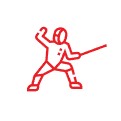Exploring the Unique Histories and Techniques of Foil, Epee, and Sabre Fencing
Azza Fencing is different from other brands. Unlike many other fencing shoes, Azza was created and developed with knowledge, experience, and care. We are not only dedicated to creating the best fencing shoe on the market for those already in the fencing world, but we also strive to grow the fencing community. This is why we are going to be more active on our blog posts to not only talk about our product, but also share information that educates our community about the unique history and culture of the sport that we all love and value.
Background and History:
Three different categories separate the sport of fencing. These categories or "weapons" have differences in rules, stylistic, and historical background. Fencing originated in the Byzantine Empire in the late sixth century. These early bouts were based on military tactics and techniques used by the Egyptians and Greeks. Fencing grew and developed around the world, with different countries creating unique styles and practices. However, several decades later, the first fencing competition took place in Great Britain in 1880 at the Grand Military Tournament. Since then, the sport has continued to grow in popularity after becoming one of the only events featured in every modern Olympic game, with the first in Athens, Greece, in 1896.
Foil:
The first modern fencing weapon is the foil. Created in the 17th century, the discipline is distinguished from the other two weapons by its metallic lamé (Electric jacket) and bib of the mask, which conducts electricity to ensure that only the neck and the torso are valid target areas.

In addition, the weapon has a small "plate-like" bellguard and unique tip that features insulating material (typically tape) to ensure the blade is insulated from the opponent's lamé (Electric jacket). In foil fencing, only the point of a weapon can score a touch.

Foil fencing utilizes a rule system called right of way to ensure that only one fencer can score a point when both opponents hit each other simultaneously and a "double touch" is recorded.
Epee:
Epee was created in the 18th century as an opposing weapon to foil fencing. With the whole body as a valid target area, epeeists are trained to hit the hand, unlike saberists, and the lower body, unlike their foil peers . As the heaviest weapon of the three, epee blades are distinguished by their rounded, large bell guards devised to protect the hand.

Unlike foil and sabre fencing, epee does not have "right of way" rules, and when a double touch is recorded, both fencers earn a point. Epeeists also have no lamé (Electric jacket) and only use the universal fencing jacket found under the lamé (Electric jacket) for the other two weapons.

Sabre:
Sabre fencing became popular in the late 1900s and was the last weapon to become popularized in the sport. In the fastest-paced weapon, fencers score touches either with the sides of their blades or the end of the blade.

A valid target is any place above the waist, including the hand. Sabre fencing also utilizes "right of way" rules like foil fencing and lamés (Electric jackets). However, Sabre lamés (Electric jackets) cover the torso and the arms, not just the torso like in foil.

In Sabre, fencers are not allowed to cross their feet while moving forward, unlike foil and epeeists

To adapt to this rule, Sabreists use the popular "flunge" action to cross large amounts of distance during an attack.
In Conclusion:
While all three weapons have their many differences, one major commonality is the supportive qualities of the Azza 15/14 shoe are used to fuel #TeamAzza fencers of all levels to reach their goals and greatest potential. The 15/14 shoe was created to support the needs of foilists, epeeists, and sabreists. From Olympians to National Champions to people just starting the sport, the 15/14 shoe protects the feet of everyone in our community. Its impact absorption, durability, toe protector, and plush feel will withstand and face the challenges of any weapon of choice.
That is all for this week! Stay tuned to our new blog for more Azza updates and future content!





